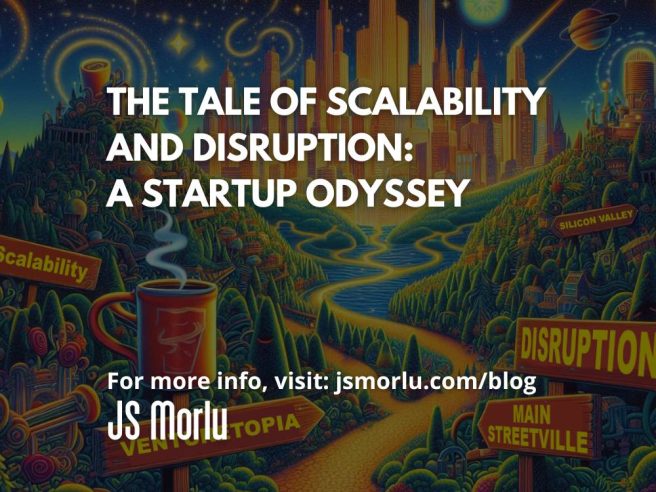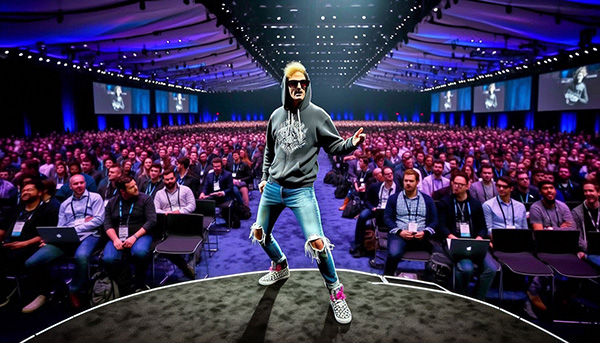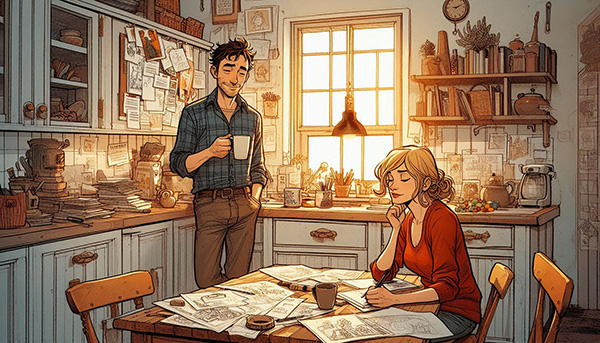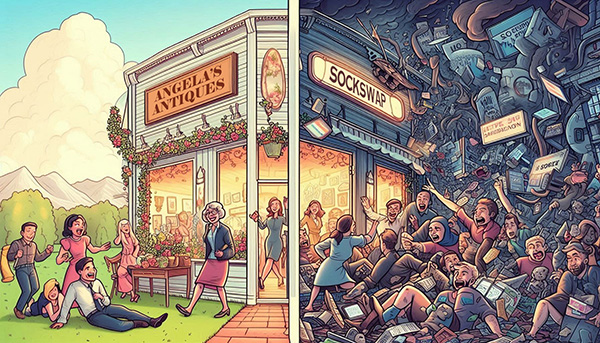By: John S. Morlu II, CPA
In the enchanting realm of Venturetopia, where caffeinated beverages are revered with the same fervor as ancient relics and office slides symbolize a company’s cultural prowess, two formidable deities reigned supreme: Scalability and Disruption. This mythical land, stretching from the tech-savvy valleys of Silicon to the frenetic jungles of Fintech, thrived on the worship of these principles. Every startup founder, from fledgling entrepreneurs to seasoned visionaries, aspired to join the exalted ranks of Uberlords and Zuckertopians, basking in the opulent glow of billion-dollar valuations and industry accolades.
Scalability and Disruption were not merely concepts; they were the golden tickets to entrepreneurial Nirvana. But what do these enigmatic terms truly entail? In Venturetopia, they are the elusive formulas whispered about in hushed tones over artisanal coffee and echoed through the gleaming halls of coworking spaces. They are tossed around with casual abandon, much like the buzzwords “synergy” and “pivot,” often without a genuine understanding of their meaning or impact.
Enter Angela, a beacon of quaint normalcy in this frenetic landscape. Angela, the proprietor of Angela’s Antiques, stood as a stark contrast to the high-tech, high-stakes world of Venturetopia. Her business was rooted not in algorithms or venture capital but in the timeworn elegance of vintage furniture and the dusty charm of forgotten trinkets. Angela’s Antiques was a haven of nostalgia nestled in the sleepy, picturesque town of Main Streetville. Unlike the hoodie-clad disruptors or tech-savvy mavens, Angela’s approach to business was grounded in tradition and heartfelt customer service.
Yet, fate had a different plan for Angela. One seemingly ordinary day, her serene existence was abruptly jolted when she received a glossy, neon flyer emblazoned with an invitation to The Disruption & Scalability Conference in the bustling metropolis. “Learn how to scale and disrupt your business!” it proclaimed, featuring a grinning tech bro clutching a laptop as though it held the secrets of the universe.
Confounded by terms like “scaling” and “disruption,” Angela, ever the open-minded entrepreneur, decided to take the plunge. Little did she know, this decision would catapult her into a whirlwind of revelations and challenges that would test her understanding of business—and perhaps reshape her very perception of success.
As Angela embarked on this journey into the heart of Venturetopia’s high-octane world, she was unprepared for the labyrinthine path that lay ahead. What awaited her was not just a seminar but an odyssey through the arcane and often bewildering realms of modern entrepreneurship.
Chapter 1: Enter the Guru: Vander Slickster
The grand hall of the Disruption & Scalability Conference was buzzing with an electric mix of excitement and trepidation. Rows of eager attendees, sporting their best startup chic—think casual blazers, asymmetrical haircuts, and the ever-present “I’m working on something big” gleam in their eyes—were seated, their faces illuminated by the soft glow of their gadgets. In this arena of innovation and self-promotion, one figure was about to take center stage: Vander Slickster, the self-styled oracle of startup success.
Vander was a legend in the world of tech wizardry, though his fame had more to do with his impressive ability to pivot on a whim than any specific product. His most celebrated venture was InstaMunch, a meal replacement company that employed the wonder of blockchain technology to deliver protein bars via drones. These weren’t just any protein bars—they were carefully crafted to resemble ancient Egyptian hieroglyphics, because nothing says “health” like a snack that requires a Rosetta Stone to decipher. His other notable creation, ShareMyDog, allowed users to rent out their pets for social media posts. Want to boost your influencer status? Why not borrow a golden retriever for a weekend, complete with matching bandanas?
As Vander strutted onto the stage, he was the epitome of startup chic: a hoodie that looked like it had been designed by a caffeinated squirrel, jeans that were so distressed they resembled Swiss cheese, and sneakers that squeaked with every step as if they were whispering startup jargon. He was a walking, talking TED Talk—minus the actual depth.
“Welcome to the future of business!” Vander bellowed, thrusting his arms upward as if trying to physically part the Red Sea of skepticism and mundane entrepreneurship. His voice was so melodramatic it could have been mistaken for a soap opera cliffhanger. “Today, I’m going to teach you how to disrupt your industry and scale your business to heights you never imagined!”
Angela, who had arrived with nothing more than her trusty notepad and a rather quaint curiosity about the modern world, found herself in the midst of what could only be described as a startup circus. Sitting near the back, she clutched her pen like it was a lifeline to sanity in a sea of buzzwords and exaggerated claims. She glanced around at her fellow attendees—most of whom seemed to be taking fervent notes, their eyes wide with what could only be described as a mixture of awe and utter confusion.
Angela had never considered herself a disruptor. Her business, Angela’s Antiques, thrived on things like stability, reliability, and the gentle patina of old-world charm. The idea of disrupting the antique industry seemed as foreign to her as sending a vintage rocking chair to the moon. Most of her customers were in their golden years, and their idea of disruption was when the cable went out during their favorite soap opera or when the local diner changed its pie recipe.
Yet, here she was, poised on the brink of a new understanding—or at least a new way to confuse her existing understanding. Vander Slickster’s promises of scaling and disruption sounded like something from a sci-fi novel, where the laws of physics could be bent, and reality itself was up for grabs. He spoke of taking businesses to “unimaginable heights” and “scaling to the stratosphere,” while Angela’s idea of scaling involved finding space for a few extra vintage lamps.
Vander continued his charismatic oration, weaving a tapestry of high-tech jargon and futuristic dreams. He spoke of algorithms and ecosystems as if they were magical incantations, and the crowd hung on his every word, hanging from his lips like they were a life raft in an ocean of mediocrity.
“Think of your business as a spaceship,” Vander instructed, pointing at the sky as if he were plotting a course to Mars. “You’ve got to get out of the atmosphere of traditionalism and into the stratosphere of innovation. With the right strategy, you could turn your little antique shop into a global phenomenon!”
Angela scribbled furiously, though her notes mostly consisted of confused doodles and the occasional question mark. She wondered if her quaint shop could really become a “global phenomenon” or if she was just in the middle of a very expensive fever dream.
As Vander concluded his rousing speech with a flourish, promising to reveal “the secrets to unimaginable success” in the upcoming breakout sessions, Angela found herself at a crossroads. She wasn’t sure if she’d just been pitched a groundbreaking new business model or if she’d been swept up in a wave of techie hyperbole.
In that moment, Angela realized that the real challenge wasn’t about understanding what Vander was preaching but figuring out how to translate his lofty visions into something that made sense for her own little corner of the business world. With a mixture of skepticism and intrigue, she prepared to dive deeper into the world of scalability and disruption, hoping to find a path that would make sense for her vintage haven—or at least provide some entertainment along the way.
Chapter 2: The Gospel of Disruption
Vander Slickster, having fully embraced his role as the high priest of modern entrepreneurship, took to the stage with the gravity of a man about to reveal the cosmic secrets of the universe. His eyes gleamed with the kind of zeal usually reserved for people who believe in conspiracy theories about alien life.
“Friends, what’s the one thing that separates the meteoric rise of successful companies from the dismal failure of those you’ve never heard of?” Vander asked, his voice dripping with dramatic suspense, as though he was about to unveil the meaning of life itself.
Angela looked around, her brain frantically searching for a correct answer. Was it the quality of products? The sheer amount of hard work? Perhaps even the elusive factor of reasonable pricing? The tension in the room was palpable as people held their breath, awaiting the revelation.
“No!” Vander bellowed, his voice reverberating through the hall with a force that could have cracked the concrete if it had tried. “It’s disruption. That’s right, disruption! You need to obliterate the old and usher in the new. Uber disrupted the taxi industry, Airbnb turned hotels on their heads, and now, you must do the same to your industries!”
Angela’s mind raced. Disruption? What did that mean for her quaint little shop? The concept of upheaving her life’s work seemed as foreign to her as using a drone to deliver a Victorian armoire.
Vander continued, his hands waving wildly as if he were conducting an orchestra of innovation. “Ask yourself: How can I take something boring and turn it into something sexy? You need to make your industry irresistible!”
Angela scratched her head, contemplating the impossibility of a “sexy” antique. What would a sultry grandfather clock look like? Maybe a vintage typewriter with a seductive new paint job? She imagined a sign in her store reading, “Come for the history, stay for the allure!”
But Vander was just getting warmed up. “Let’s take a closer look at Angela’s Antiques,” he said with a flourish. Angela jumped in her seat, her eyes wide with disbelief. Was he actually referring to her? Her shop? Had her humble establishment become the center of Vander’s cosmic vision?
“Right now,” Vander continued, his tone shifting to that of a charismatic fortune-teller, “you sell old things. But instead of sticking with the conventional, why not create a platform for ‘antique-sharing’?”
Angela blinked. “Antique-sharing?” she repeated under her breath. “Isn’t that just… lending?”
“Yes, antique-sharing!” Vander exclaimed, as though he had just unveiled the latest breakthrough in quantum physics. “Picture this: an app where people can rent vintage furniture by the hour for their social media posts. Millennials and Gen Z are obsessed with unique experiences. Imagine a platform where someone can rent a 19th-century lamp for a chic Instagram selfie. They can caption their photos with ‘Sitting pretty since 1890’ and watch the likes roll in!”
The room buzzed with excitement as attendees nodded vigorously, caught up in the thrill of the idea. They could practically see the likes and comments pouring in on their feeds. Angela, on the other hand, struggled to visualize it. Renting out a Victorian chair for thirty minutes just so someone could brag about their antiquated taste on social media seemed like a bizarre, futuristic dream.
She imagined someone curating their Instagram post: “Check out my new living room set from 1875! It’s vintage and trendy!” Angela shuddered at the thought. What would her loyal customers think of this newfangled approach? The idea of renting out her prized 19th-century lamp for a selfie seemed about as practical as using a steam engine for a coffee run.
Still, the concept was intriguing. Maybe she was indeed out of touch. Maybe people genuinely wanted to hire a retro rocking chair for a brief moment of Instagram fame. Could she really be that behind the curve? Angela had always prided herself on her traditional values, but perhaps the times were changing faster than she had anticipated.
As Vander continued to extol the virtues of disruptive innovation and scalable platforms, Angela found herself caught in a whirlwind of ideas and doubts. She had come to the seminar with a modest hope of finding ways to improve her business, but now she was grappling with the notion of transforming her beloved antiques into ephemeral social media props.
And so, as Vander wrapped up his sermon, promising to delve deeper into the mechanics of disruption in the coming sessions, Angela felt a mix of bewilderment and cautious optimism. She had ventured into the realm of the extraordinary, and whether she would emerge with a groundbreaking new approach or just a newfound appreciation for her antiques’ timeless charm remained to be seen.
Chapter 3: Scalability: The Holy Grail
As the conference room lights dimmed to a dramatic glow, the anticipation in the air was so thick you could almost cut it with a vintage butter knife. The time had come for Vander Slickster to introduce the most sacred and elusive concept in the startup cosmos: Scalability. It was the Holy Grail of business, the unicorn of entrepreneurial dreams, and Vander treated it with the reverence usually reserved for ancient relics or celebrity gossip.
“If your business isn’t scalable,” Vander declared, his voice echoing with the weight of prophecy, “it’s doomed to mediocrity! You need to think bigger, Angela! Start with your little antique shop, but then scale! The world is your oyster—or rather, your antique teapot. Ask yourself: How can you turn this into a platform?”
Angela, who had been running her cozy shop for two decades with a straightforward and successful business model, was now grappling with the concept of “scaling” her antiques. Her shop was profitable, her customers were happy, and she had never needed an app to sell teacups. The notion of scaling antiques seemed as practical as converting a horse-drawn carriage into a jet ski.
Vander, ever the perceptive guru, zeroed in on Angela’s puzzled expression as if he had just spotted an unsolved Rubik’s cube in a room full of crossword puzzles.
“Angela,” Vander said, his voice dropping to a conspiratorial whisper as if sharing the secret recipe for the world’s most coveted elixir, “here’s what you’re missing. You don’t just sell antiques. You sell experiences. You sell nostalgia! Now, imagine if you could sell nostalgia to everyone at once!”
Angela’s eyes widened. Nostalgia to everyone at once? This was sounding more like a sci-fi plot than practical business advice. Her shop had always been about personal touch, not some mass-market nostalgia factory.
Vander continued, his enthusiasm bubbling over like a soda shaken one too many times. “Picture this: a subscription service. People pay a monthly fee to receive hand-picked vintage items delivered right to their door. You could call it… NostalgiaBox! Each month, they get a curated selection of antiques, each item brimming with charm and history. You’re not just selling old stuff—you’re delivering a monthly dose of history and sentimentality. And boom—you’ve scaled!”
The room erupted into applause as though Vander had just unveiled the next big tech breakthrough. The attendees clapped with the fervor of people who had just discovered the cure for boredom. Angela, on the other hand, was left blinking in disbelief. A subscription service? NostalgiaBox? What had happened to simply selling nice furniture?
She imagined the logistics of her new venture. Boxes of vintage teacups, framed sepia-toned photographs, and ornate picture frames—each lovingly packed and shipped to customers eagerly awaiting their monthly dose of “retro” surprise. Would she need a new warehouse? A team of vintage curators? What about those customers who only wanted one antique, not an entire box of them?
Angela pictured herself as the queen of NostalgiaBox, ruling over a kingdom of monthly nostalgia shipments, complete with a crown made of antique spoons and a scepter fashioned from a gilded picture frame. She could already see it now: “Queen Angela, the Purveyor of Past,” reigning over a subscription empire with a warm, nostalgic smile.
But then, her practical side kicked in. Would people really subscribe to receiving old items in the mail every month? Would her antique treasures lose their allure if they were mass-produced in cardboard boxes? And most importantly, could she handle the avalanche of logistics, packaging, and potential “this item doesn’t match the photo” complaints?
Vander, sensing her hesitation, leaned in with an encouraging grin. “Angela, think of it this way: NostalgiaBox turns every month into a journey through time. Each box is a treasure hunt, a way for people to reconnect with the past while staying comfortably in their present. It’s the ultimate blend of history and convenience!”
Angela tried to wrap her head around it. The idea was fascinating, if not a little overwhelming. She imagined customers eagerly unwrapping their monthly nostalgia boxes, sharing their finds on social media, and posting reviews that read like poetic odes to bygone eras.
As Vander wrapped up his pep talk on scalability, promising to dive deeper into the mechanics of building a subscription empire in the next session, Angela found herself torn between excitement and anxiety. She had ventured into the land of startups with a simple desire to improve her business, but now she was navigating a whirlwind of subscription services and scalability dreams.
As she left the session, Angela couldn’t help but chuckle at the absurdity of it all. NostalgiaBox might be a revolutionary idea, but she still had a soft spot for her charming, unpretentious antique shop. Maybe she’d take a middle path—explore new ideas while staying true to the heart of what made her business special.
In the grand, chaotic world of scalability and disruption, Angela was learning that the real magic lay in finding the right balance between innovation and authenticity. And who knew? Maybe NostalgiaBox would turn out to be the ticket to her next great adventure—or at the very least, a hilarious chapter in her ongoing journey through the whimsical world of business.
Chapter 4: Angela’s Grand Epiphany
Angela stumbled through the door of her quaint little house, her mind still swirling from the day’s seminar. The dizzying array of ideas—pivoting her business, launching an antique-sharing app, and disrupting the market with a subscription service for vintage gravy boats—had left her feeling like she’d just been on a rollercoaster designed by an over-caffeinated entrepreneur. Now, she faced the Herculean task of trying to make sense of it all.
Her kitchen table had become a battlefield of brainstorming, strewn with half-eaten sandwiches, a stack of business cards, and a crumpled flyer for NostalgiaBox. Angela plopped down, determined to sketch out her next big move. She tried to draw a business model for the subscription service but instead ended up doodling an epic saga of antique robots with elaborate porcelain legs marching through a futuristic landscape. The vision of teacups with laser beams and armoires sporting bionic limbs was both amusing and entirely unhelpful.
Just then, her husband Frank ambled in, his face the very picture of practical wisdom and coffee addiction. Frank was the kind of guy who considered “disruption” to be when the dog chewed up his favorite slippers and “scalability” meant fitting more tomato plants into their already overstuffed garden beds without declaring war on the lawn.
“What’s bothering you, Ang?” Frank asked, pouring himself a steaming cup of coffee. The smell of the freshly brewed java seemed to cut through the chaos in Angela’s mind, if only for a moment.
Angela sighed deeply, her fingers drumming a restless rhythm on the table. “I went to this seminar today about scaling and disrupting my business. They said we need to turn antiques into a platform or something. Maybe I should start a subscription box for vintage teacups or rent out antiques by the hour to Instagram influencers.”
Frank, his eyebrows performing an impressive acrobatic feat of skepticism, regarded her with a mixture of amusement and confusion. “A subscription box for teacups?”
Angela nodded, her eyes widening with the fervor of a true believer. “Or how about renting out antiques for Instagram selfies? Can you imagine someone taking a picture with a Victorian chair and hashtagging it #ThrowbackChic?”
Frank took a slow sip of his coffee, his expression shifting from baffled to contemplative. “Are you serious about this?”
Angela threw her hands up in exasperation. “I don’t know! Everyone seems obsessed with disrupting things and scaling businesses. They talk about it like it’s the holy grail of entrepreneurship. What if we don’t ‘scale’? We’ll end up like Blockbuster, left in the dust of innovation!”
Frank chuckled, a sound that was like the delightful tinkling of a bell in Angela’s cluttered mind. “Angela, you’ve been running your shop for 20 years. Your customers love what you do. You’ve got a loyal following because you sell good stuff. You don’t need to disrupt anything. You just need to keep doing what you’re doing.”
Angela stared at him, her thoughts swirling. “But what if I’m missing something? What if there’s a chance to be the next big thing? What if we could be a game-changer?”
Frank leaned back, his expression a mix of amusement and practical concern. “And what if you ended up pouring a bunch of money into an app that no one uses? Your customers aren’t asking for a ‘disruption’—they just want a reliable place to find a nice chair that doesn’t collapse under them.”
Angela’s laugh came like a breath of fresh air. Frank’s pragmatic wisdom cut through the fog of startup jargon and high-flown ideals. Her customers weren’t demanding futuristic tech or subscription services. They simply appreciated the unique charm and quality of her antiques.
“Maybe you’re right,” Angela admitted, feeling the weight of the day’s absurdities lifting. “My customers don’t want to rent a Victorian chair for an Instagram post. They want a place where they can find something special, something with a story.”
Frank grinned, his eyes twinkling with a mix of relief and humor. “Exactly. Sometimes, the best way to stay relevant is to stay true to what you’re good at. You don’t need to turn your antique shop into a tech startup. Just keep being Angela.”
Angela looked around her cozy kitchen, her thoughts settling like the fine china she lovingly displayed in her shop. The seminar had certainly introduced her to a world of possibilities, but it had also made her realize the beauty of sticking to her roots. She didn’t need to chase the latest trends or become the next big thing. She needed to focus on what made her business unique—her passion for antiques and her commitment to quality.
As she tidied up her sketches of robotic armoires and retro teacups, Angela felt a renewed sense of clarity. She would continue to offer her customers the personal touch and timeless treasures they cherished, and maybe, just maybe, she’d explore a few new ideas without losing sight of what made her shop special.
With a smile, Angela hugged Frank. “Thanks for helping me see things more clearly. Now, how about we keep things simple and just enjoy a nice cup of coffee? No scaling, no disruption—just us and our comfy kitchen.”
Frank laughed, wrapping his arm around her. “Sounds like a plan. And who knows? Maybe a little bit of nostalgia is all we need.”
As they clinked their coffee mugs together, Angela felt a sense of peace. In the end, it wasn’t about chasing the latest buzzwords or following every trend—it was about finding joy in the simple things and staying true to herself. And that, she realized, was the best kind of disruption of all.
Chapter 5: The Real Lesson: Not Every Business Needs to Disrupt
In the wake of the Disruption & Scalability Conference, Angela took a moment to breathe, her mind finally finding some respite from the whirlwind of techno-babble and entrepreneurial hyperbole. The terms “Scalability” and “Disruption” had sounded so glamorous, like secret codes to unlock the treasure chest of entrepreneurial success. But as Angela pondered her next steps, she realized she didn’t need to reinvent the antique wheel. She didn’t need a mobile app to sell teacups or a blockchain-powered subscription service for vintage gravy boats. What she needed was a good, old-fashioned dose of customer care and a touch of practical innovation.
Angela rolled up her sleeves and got to work. She began by giving her shop’s website a much-needed facelift. Out went the cobwebs and in came a sleek, modern design that was easier on the eyes than her grandmother’s floral wallpaper. She didn’t need an app to sell antiques; a well-organized website and some compelling photos of her treasures would do just fine. She even started a weekly email newsletter, not to hawk subscription boxes, but to share valuable tips on caring for vintage items. The newsletters featured helpful advice, like how to properly polish silver without turning it into a shiny blob or how to spot a genuine 19th-century rocking chair from a mile away.
But Angela didn’t stop there. Inspired by her newfound clarity, she began hosting workshops in her shop. These were not your average “learn to craft with beads” classes, but rather immersive experiences into the world of antiques. Locals came in droves to hear stories about the history of their cherished items, and Angela’s shop became a haven for those looking to connect with the past in a meaningful way. The workshops were a hit, and her customers loved the personal touch.
Meanwhile, back in the glittering land of Venturetopia, Vander Slickster was busy working on his latest brainchild: SockSwap. This revolutionary platform promised to shake up the world of hosiery by allowing people to rent pairs of socks for special occasions. That’s right—renting socks. The idea was so disruptive, it had garnered a $10 billion valuation almost overnight. Investors were enamored with the concept until they realized that, shockingly, people actually preferred to buy their own socks. Who would have guessed?
SockSwap’s grand launch turned into a spectacular fiasco as Vander’s team struggled to convince people that their social lives were incomplete without rented socks for their “Sock-Matching” parties. It turned out that most people were perfectly content with their existing sock collections and didn’t see the need to swap out their foot coverings for a temporary social statement.
As for Angela, she was living proof that sometimes the simplest approach is the most effective. She didn’t need to disrupt or scale her business in flashy ways. She found success by focusing on what mattered most—her customers. The antique market wasn’t ready for radical innovation, but it thrived on personal connections and quality service. Angela’s Antiques became a beloved fixture in her community, cherished for its authenticity and the personal touch Angela brought to every interaction.
Angela knew she had made the right decision. Her shop was thriving, her customers were delighted, and she had managed to avoid falling into the trap of chasing the next big thing just for the sake of it. She had successfully navigated the labyrinth of buzzwords and business fads, emerging with a clear understanding of what really mattered.
So, while Vander Slickster’s SockSwap became a cautionary tale of overhyped disruption, Angela’s Antiques remained a testament to the power of sticking to one’s roots. Angela didn’t need to scale or disrupt to achieve success. She simply needed to stay true to her values and continue providing exceptional service.
In the end, Angela learned that the real key to business success isn’t found in the latest trends or most disruptive ideas. It’s in the heart of what you do, the relationships you build, and the quality you maintain. And as she watched her shop flourish, Angela couldn’t help but smile, knowing she had found her own version of success—one that didn’t require a pair of rented socks or a flashy new app.
Author: John S. Morlu II, CPA is the CEO and Chief Strategist of JS Morlu, leads a globally recognized public accounting and management consultancy firm. Under his visionary leadership, JS Morlu has become a pioneer in developing cutting-edge technologies across B2B, B2C, P2P, and B2G verticals. The firm’s groundbreaking innovations include AI-powered reconciliation software (ReckSoft.com) and advanced cloud accounting solutions (FinovatePro.com), setting new industry standards for efficiency, accuracy, and technological excellence.
JS Morlu LLC is a top-tier accounting firm based in Woodbridge, Virginia, with a team of highly experienced and qualified CPAs and business advisors. We are dedicated to providing comprehensive accounting, tax, and business advisory services to clients throughout the Washington, D.C. Metro Area and the surrounding regions. With over a decade of experience, we have cultivated a deep understanding of our clients’ needs and aspirations. We recognize that our clients seek more than just value-added accounting services; they seek a trusted partner who can guide them towards achieving their business goals and personal financial well-being.
Talk to us || What our clients says about us







